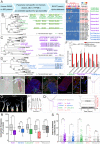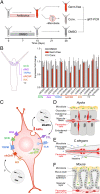Prototypical pacemaker neurons interact with the resident microbiota
- PMID: 32647059
- PMCID: PMC7395494
- DOI: 10.1073/pnas.1920469117
Prototypical pacemaker neurons interact with the resident microbiota
Abstract
Pacemaker neurons exert control over neuronal circuit function by their intrinsic ability to generate rhythmic bursts of action potential. Recent work has identified rhythmic gut contractions in human, mice, and hydra to be dependent on both neurons and the resident microbiota. However, little is known about the evolutionary origin of these neurons and their interaction with microbes. In this study, we identified and functionally characterized prototypical ANO/SCN/TRPM ion channel-expressing pacemaker cells in the basal metazoan Hydra by using a combination of single-cell transcriptomics, immunochemistry, and functional experiments. Unexpectedly, these prototypical pacemaker neurons express a rich set of immune-related genes mediating their interaction with the microbial environment. Furthermore, functional experiments gave a strong support to a model of the evolutionary emergence of pacemaker cells as neurons using components of innate immunity to interact with the microbial environment and ion channels to generate rhythmic contractions.
Keywords: Hydra; antimicrobial peptide; ion channel; microbiome; pacemaker neuron.
Copyright © 2020 the Author(s). Published by PNAS.
Conflict of interest statement
The authors declare no competing interest.
Figures




Comment in
-
Linking neurons to immunity: Lessons from Hydra.Proc Natl Acad Sci U S A. 2020 Aug 18;117(33):19624-19626. doi: 10.1073/pnas.2011637117. Epub 2020 Aug 5. Proc Natl Acad Sci U S A. 2020. PMID: 32759220 Free PMC article. No abstract available.
References
-
- Sasselli V., Pachnis V., Burns A. J., The enteric nervous system. Dev. Biol. 366, 64–73 (2012). - PubMed
-
- Olsson C., Holmgren S., The control of gut motility. Comp. Biochem. Physiol. A Mol. Integr. Physiol. 128, 481–503 (2001). - PubMed
-
- Barajas-López C., Berezin I., Daniel E. E., Huizinga J. D., Pacemaker activity recorded in interstitial cells of Cajal of the gastrointestinal tract. Am. J. Physiol. 257, C830–C835 (1989). - PubMed
Publication types
MeSH terms
Grants and funding
LinkOut - more resources
Full Text Sources

